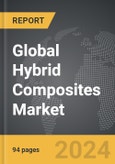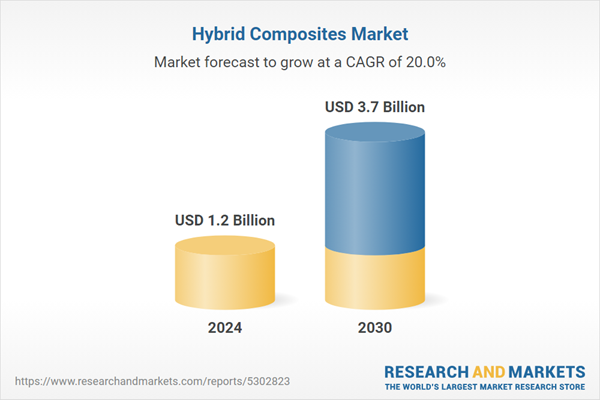The global market for Hybrid Composites was valued at US$1.2 Billion in 2024 and is projected to reach US$3.7 Billion by 2030, growing at a CAGR of 20.0% from 2024 to 2030. This comprehensive report provides an in-depth analysis of market trends, drivers, and forecasts, helping you make informed business decisions. The report includes the most recent global tariff developments and how they impact the Hybrid Composites market.
Segments: Fiber Type (Carbon / Glass, Aramid / Carbon, HMPP, UHMWPE, Other Fiber Types); Application (Automotive & Transportation, Aerospace & Defense, Wind Energy, Marine, Sporting Goods, Other Applications).
Geographic Regions/Countries: World; United States; Canada; Japan; China; Europe (France; Germany; Italy; United Kingdom; and Rest of Europe); Asia-Pacific; Rest of World.
The analysts continuously track trade developments worldwide, drawing insights from leading global economists and over 200 industry and policy institutions, including think tanks, trade organizations, and national economic advisory bodies. This intelligence is integrated into forecasting models to provide timely, data-driven analysis of emerging risks and opportunities.
Global Hybrid Composites Market - Key Trends and Drivers Summarized
Why Are Hybrid Composites Crucial for Advanced Engineering Applications?
Hybrid composites are increasingly becoming vital in engineering applications due to their ability to combine different materials, such as fibers and resins, to create composites with enhanced mechanical properties. These composites offer the best of both worlds, combining the lightweight and high-strength characteristics of materials like carbon fiber with the flexibility and toughness of other fibers like glass or aramid. Hybrid composites are extensively used in industries such as aerospace, automotive, and renewable energy, where materials are required to be both strong and lightweight to improve performance and energy efficiency. As technological demands in these industries continue to grow, hybrid composites provide the versatility and adaptability needed to meet stringent performance requirements.How Are Technological Innovations Shaping the Hybrid Composites Market?
Technological advancements in fiber reinforcement and resin systems have significantly improved the properties and production processes of hybrid composites. Innovations such as automated fiber placement (AFP) and advanced resin transfer molding (RTM) techniques have increased the efficiency and precision of hybrid composite manufacturing. These methods allow for better control of fiber orientation and resin distribution, resulting in composites with superior strength-to-weight ratios and enhanced durability. Moreover, advancements in nanotechnology have introduced the integration of nanofibers into hybrid composites, further improving their mechanical and thermal properties. These innovations are enabling the production of more complex and highly specialized composites for cutting-edge applications.How Do Market Segments Define Growth in the Hybrid Composites Industry?
Fiber types include carbon-glass, carbon-aramid, and glass-aramid composites, with carbon-glass composites leading the market due to their superior strength and lightweight characteristics. Resin types include thermoset and thermoplastic, with thermoset resins holding the largest share as they offer greater resistance to heat and chemicals, making them ideal for aerospace and automotive applications. Applications of hybrid composites range from structural components in aircraft and automobiles to wind turbine blades in the renewable energy sector, with aerospace being the largest end-user due to the demand for materials that offer high performance under extreme conditions.What Factors Are Driving the Growth in the Hybrid Composites Market?
The growth in the hybrid composites market is driven by several factors, including the increasing demand for lightweight and high-strength materials, advancements in manufacturing technologies, and the growing adoption of hybrid composites in aerospace and automotive industries. As industries seek to improve energy efficiency and reduce environmental impact, hybrid composites provide the ideal solution by offering both strength and weight reduction. The use of hybrid composites in electric vehicles (EVs) and renewable energy projects, such as wind turbines, is also expanding as manufacturers aim to enhance performance while minimizing material usage. Furthermore, advancements in automated manufacturing techniques, such as AFP and RTM, are making hybrid composites more accessible and cost-effective, further fueling market growth.Report Scope
The report analyzes the Hybrid Composites market, presented in terms of units. The analysis covers the key segments and geographic regions outlined below.Segments: Fiber Type (Carbon / Glass, Aramid / Carbon, HMPP, UHMWPE, Other Fiber Types); Application (Automotive & Transportation, Aerospace & Defense, Wind Energy, Marine, Sporting Goods, Other Applications).
Geographic Regions/Countries: World; United States; Canada; Japan; China; Europe (France; Germany; Italy; United Kingdom; and Rest of Europe); Asia-Pacific; Rest of World.
Key Insights:
- Market Growth: Understand the significant growth trajectory of the Carbon / Glass segment, which is expected to reach US$1.9 Billion by 2030 with a CAGR of a 22.1%. The Aramid / Carbon segment is also set to grow at 20.3% CAGR over the analysis period.
- Regional Analysis: Gain insights into the U.S. market, valued at $350.6 Million in 2024, and China, forecasted to grow at an impressive 18.8% CAGR to reach $549.8 Million by 2030. Discover growth trends in other key regions, including Japan, Canada, Germany, and the Asia-Pacific.
Why You Should Buy This Report:
- Detailed Market Analysis: Access a thorough analysis of the Global Hybrid Composites Market, covering all major geographic regions and market segments.
- Competitive Insights: Get an overview of the competitive landscape, including the market presence of major players across different geographies.
- Future Trends and Drivers: Understand the key trends and drivers shaping the future of the Global Hybrid Composites Market.
- Actionable Insights: Benefit from actionable insights that can help you identify new revenue opportunities and make strategic business decisions.
Key Questions Answered:
- How is the Global Hybrid Composites Market expected to evolve by 2030?
- What are the main drivers and restraints affecting the market?
- Which market segments will grow the most over the forecast period?
- How will market shares for different regions and segments change by 2030?
- Who are the leading players in the market, and what are their prospects?
Report Features:
- Comprehensive Market Data: Independent analysis of annual sales and market forecasts in US$ Million from 2024 to 2030.
- In-Depth Regional Analysis: Detailed insights into key markets, including the U.S., China, Japan, Canada, Europe, Asia-Pacific, Latin America, Middle East, and Africa.
- Company Profiles: Coverage of players such as C. Cramer, Weberei, GmbH & Co., Kg, Exel Composites PLC, General Electric, Gurit, Hexcel Corporation and more.
- Complimentary Updates: Receive free report updates for one year to keep you informed of the latest market developments.
Some of the 43 companies featured in this Hybrid Composites market report include:
- C. Cramer, Weberei, GmbH & Co., Kg
- Exel Composites PLC
- General Electric
- Gurit
- Hexcel Corporation
- Innegra Technologies, LLC
- Plasticomp, Inc.
- Quantum Composites
- Royal DSM N.V
- SGL Group
- Solvay
- Taiwan Taiyuan Composites Co., Ltd.
- Talon Technology
- Teijin Limited
- Textum Inc
Tariff Impact Analysis: Key Insights for 2025
Global tariff negotiations across 180+ countries are reshaping supply chains, costs, and competitiveness. This report reflects the latest developments as of April 2025 and incorporates forward-looking insights into the market outlook.The analysts continuously track trade developments worldwide, drawing insights from leading global economists and over 200 industry and policy institutions, including think tanks, trade organizations, and national economic advisory bodies. This intelligence is integrated into forecasting models to provide timely, data-driven analysis of emerging risks and opportunities.
What’s Included in This Edition:
- Tariff-adjusted market forecasts by region and segment
- Analysis of cost and supply chain implications by sourcing and trade exposure
- Strategic insights into geographic shifts
Buyers receive a free July 2025 update with:
- Finalized tariff impacts and new trade agreement effects
- Updated projections reflecting global sourcing and cost shifts
- Expanded country-specific coverage across the industry
Table of Contents
I. METHODOLOGYII. EXECUTIVE SUMMARY2. FOCUS ON SELECT PLAYERSIII. MARKET ANALYSISIV. COMPETITION
1. MARKET OVERVIEW
3. MARKET TRENDS & DRIVERS
4. GLOBAL MARKET PERSPECTIVE
UNITED STATES
CANADA
JAPAN
CHINA
EUROPE
FRANCE
GERMANY
ITALY
UNITED KINGDOM
REST OF EUROPE
ASIA-PACIFIC
REST OF WORLD
Companies Mentioned (Partial List)
A selection of companies mentioned in this report includes, but is not limited to:
- C. Cramer, Weberei, GmbH & Co., Kg
- Exel Composites PLC
- General Electric
- Gurit
- Hexcel Corporation
- Innegra Technologies, LLC
- Plasticomp, Inc.
- Quantum Composites
- Royal DSM N.V
- SGL Group
- Solvay
- Taiwan Taiyuan Composites Co., Ltd.
- Talon Technology
- Teijin Limited
- Textum Inc
Table Information
| Report Attribute | Details |
|---|---|
| No. of Pages | 94 |
| Published | April 2025 |
| Forecast Period | 2024 - 2030 |
| Estimated Market Value ( USD | $ 1.2 Billion |
| Forecasted Market Value ( USD | $ 3.7 Billion |
| Compound Annual Growth Rate | 20.0% |
| Regions Covered | Global |









